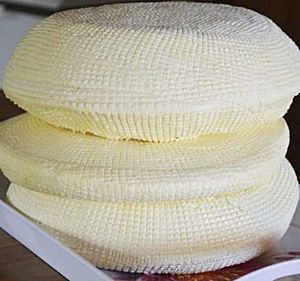Paraguay cheese facts for kids
Paraguay cheese, known as queso Paraguay in Spanish and kesú paraguai in Guaraní, is a special cheese from Paraguay. It's made from cow's milk. This cheese adds lots of energy and protein to Paraguayan food. It's a key ingredient in many traditional salty dishes, making it an important part of the country's culture.
This cheese is made from something called "curd." Curd is formed when milk is mixed with "rennet." Rennet is a natural substance that helps milk thicken and turn into cheese. Paraguay cheese is usually a bit salty and very creamy. It's also super nutritious because it's made with whole milk. It has a soft texture and a slightly sour taste. You can keep it fresh for about 45 days.
Contents
Name Origin: Kesú Paraguai
The name kesú paraguai comes from two words. It combines "queso," which means cheese in Spanish, and "Paraguay," the name of the country. These words were changed to fit the Guaraní language.
In Guaraní, the letter "y" is pronounced differently than in Spanish. It also means "water." So, to avoid confusion, the name uses an "i" instead of a "y" at the end of "paraguai."
How Paraguay Cheese is Made
Making Paraguay cheese involves two main ingredients: whole milk and rennet. The process has three main steps: preparing the rennet, making the curd, and finally shaping the cheese.
Preparing the Rennet
First, the rennet is carefully cleaned. Then, it's placed in a container with a lot of sour orange or lemon juice. It soaks there for about three to four hours. After soaking, it's taken out and left to dry in the sun. Once it's dry, the rennet is ready to help curdle the milk.
Making the Curd
Next, whole milk is poured into a container. The prepared rennet is added to the milk. The mixture is stirred gently every now and then for about an hour. To check if it's ready, a small amount of the liquid is dropped into your hand. If small clumps, or curds, have formed, the rennet is removed. The milk is then left alone for a short time to finish the curdling process.
Shaping the Cheese
Finally, the curd is broken up. It's then left to sit for a few more hours. During this time, it loses some liquid called "whey." After this, the curd is squeezed until all the whey is gone. Once the curd is dry, it's placed into special rectangular molds called cheese-dishes. The very next day, the kesú paraguai is ready to be enjoyed!
History of Paraguay Cheese
The tradition of making kesú paraguai began in the countryside areas of Paraguay. These areas were known for farming and raising cattle.
After the Paraguayan War (1864-1870), food was often scarce in Paraguay. This war involved Paraguay fighting against Argentina, Brazil, and Uruguay. Because food was hard to find, Paraguayan cooking became very rich in calories and protein. This helped people get enough energy and nutrients from their meals. Making cheese became a small family business, helping to provide important food after the war.
See also
 In Spanish: Queso Paraguay para niños
In Spanish: Queso Paraguay para niños


